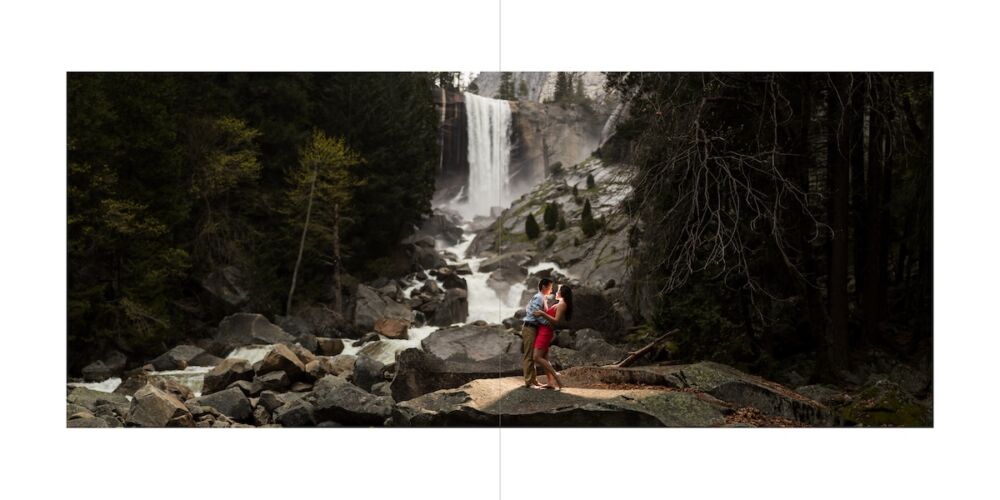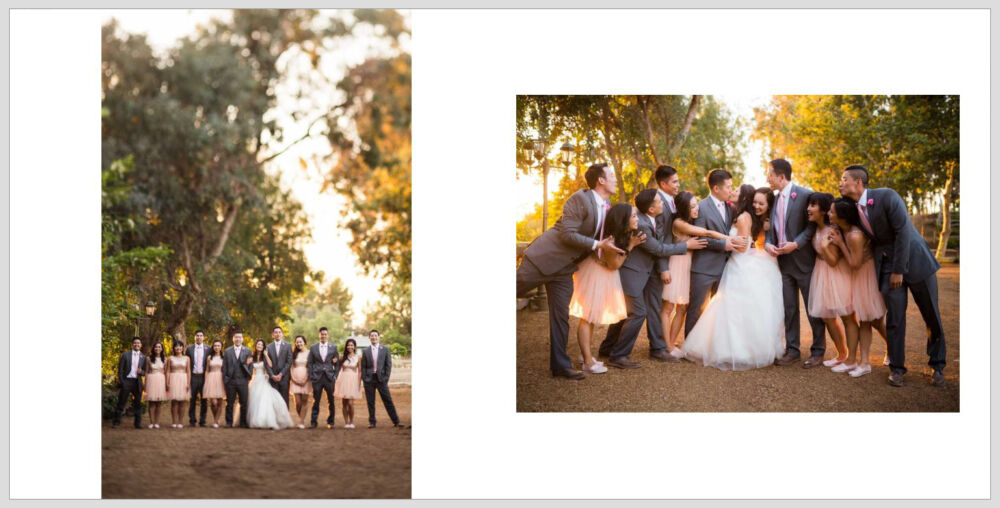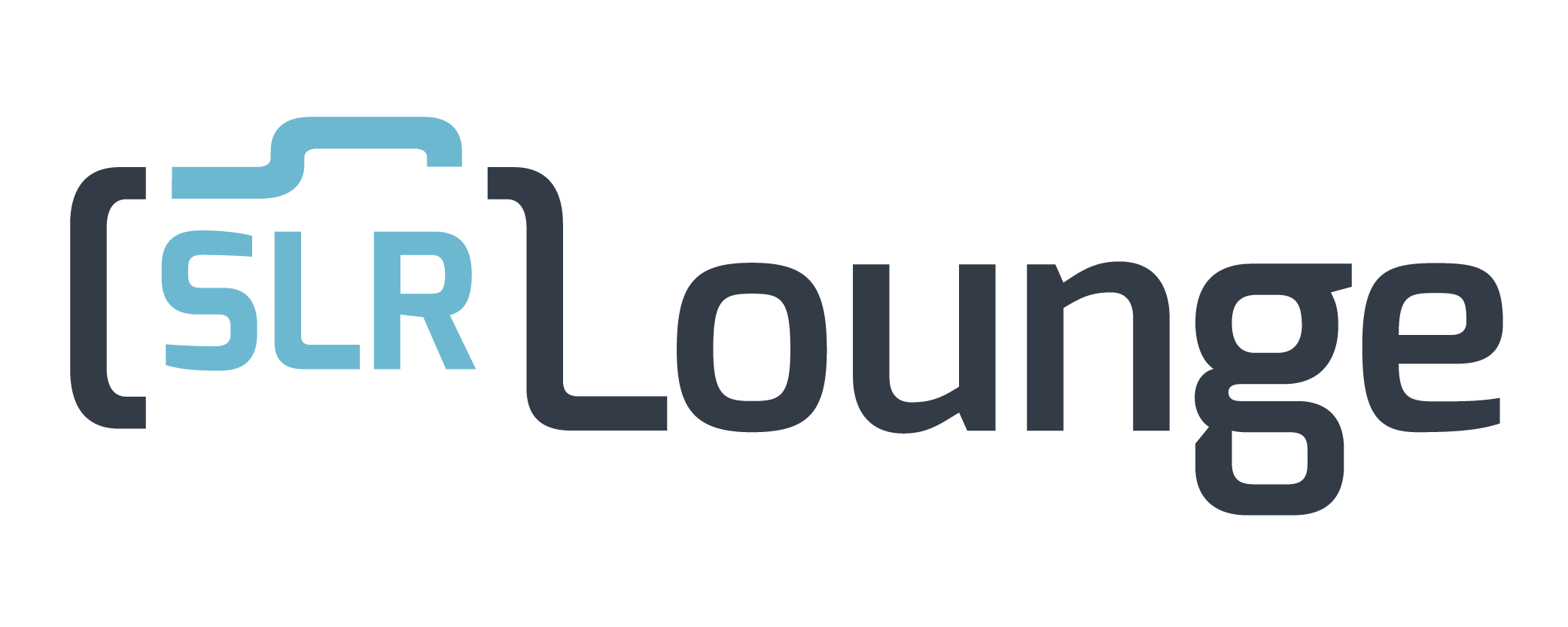Choosing the right orientation for a photo album may seem like a small detail, but it can significantly impact the final presentation and overall impact of your images. The chosen photo album dimensions can also affect design choices, image selection, and even storage convenience. So whether you’re a professional photographer creating albums for clients or organizing personal photos, selecting the best orientation—landscape, portrait, or square— for your style and intent can enhance storytelling, increase the overall impact of the images, and create a cohesive look. This guide explores the pros and cons of each orientation, common photo album sizes, and when to use each orientation for the best results.
Horizontal Albums (Landscape Orientation)
Landscape-oriented albums are wider than they are tall, resembling a horizontal rectangle. This is often the go-to format for traditional wedding albums, travel photography, and landscape or outdoor photography.

Landscape (Horizontal) Album Pros
- Natural Eye Movement – When multiple images are laid out across a full horizontal spread, your eyes travel from left to right without any awkward transitions. A single landscape image fits nicely onto a single horizontal side, leaving you with the other side for supporting images. To achieve a high visual impact. Consider using a single landscape image and have it span the full spread.
- Versatile Layout for Horizontal Images: Since most photos are taken in landscape orientation, this format naturally fits many images without cropping or rotating.
- Great for Panoramas and Large Groups: Landscape orientation accommodates wider shots, making it ideal for group photos, landscape scenes, or wide-angle shots.
- Natural for Storytelling: Spreads flow seamlessly across the width of the album, which makes storytelling across multiple pages feel more continuous.

Landscape (Horizontal) Album Cons:
- Limited Flexibility for Vertical Photos – Portrait photos may need to be cropped or scaled down, which can reduce image quality.
- Larger Size Requirements – To fit a balance of vertical and horizontal photos, landscape albums often need larger dimensions, which can be bulky.
- Harder to Carry and Store – A horizontal album is more likely to have its edge hang off of the edge of a bookshelf than a vertical or square album, making it harder to store. In addition, opening and turning the pages of the photo album can feel less natural, and viewing the album may have to be done on a table.
- More Weight on the Book Spine – Horizontal albums place more weight on the spine than vertical or square albums, which can potentially lead to shorter lifespans. While this isn’t a problem with high quality, professional album makers, the issue may arise with consumer or budget makers.
Common Sizes for Landscape Albums:
- 11×8.5 inches
- 12×9 inches
- 13×10 inches
Landscape-oriented albums are perfect for wedding photography, travel albums, nature and landscape photography, or any collection where horizontal images are predominant.
Square Albums – The Most Versatile Orientation
Back in the days, most antiquated “slip-in” photo albums were square shaped. It was done on purpose because it allowed the slip-in mats to “rotate” and provided more versatility for the mats. Nowadays, with modern flush mount photo albums, this no longer applies, but we still see a huge popularity with squared-sized photo albums.

Square Album Pros:
- Easy to Resize – One practical reason for square photo albums is that they are extremely easy to resize. Simply design a large size photo album and you can order any other smaller square sizes without lifting a finger! No need to worry if the aspect ratios are compatible or not.
- Equal Emphasis on All Photos: Since the album doesn’t prioritize one orientation, it’s versatile enough for a mix of horizontal and vertical images.
- Modern and Clean Aesthetic: Square albums are often seen as contemporary and stylish, making them popular for high-end or art-focused collections.
- Perfect for Social Media Photos: Many social media images, especially from platforms like Instagram, are square, so this format translates perfectly from screen to print.
- Great for Wedding Parent Albums – If you are offering parent albums at different sizes, square will be the easiest and most versatile album orientation.

Square Album Cons:
- Cropping Necessary – Design wise, square albums fall into the “middle-of-the-road” category. If you have a nice landscape image, it can fit perfectly across a full spread (2 squares). Other than that, if you try to full bleed either a horizontal or vertical image into a single square side, you would need to some heavy cropping. Fitting multiple images into a single square side is also a labor of compromise. Let’s say you want 4 horizontal images on a single square side….you would wound up with some awkward space on the top and bottom. Likewise, fitting 4 vertical images on a single square side will yield awkward space on the left and right side.
- May Not Suit Traditional Styles: For some traditional albums, square orientation may feel less formal or polished, depending on the theme.
Common Sizes for Square Albums:
- 8×8 inches
- 10×10 inches
- 12×12 inches
Square-oriented albums are excellent for social media photo books, baby albums, family memories, and creative portfolios. Square albums provide a balanced and modern feel. They’re versatile and work well for both landscape and portrait images, making them a popular choice for digital scrapbooks, social media photo books, and art-focused albums.
Square Album Spread Examples
See a few examples of square photo album spreads by Lin and Jirsa Photography.



Vertical Photo Albums
A photo album with portrait (vertical) orientation is taller than it is wide, resembling a vertical rectangle. This format is frequently used for school yearbooks, formal portraits, and some family albums. When done right, the vertical album has a very uniquely shaped photo album that stands out from the crowd. When done wrong, the viewer might drop the dreaded comment, “Oh, that looks like a yearbook…”.

Portrait (Vertical) Album Pros:
- Ideal for Vertical Photos: Portrait orientation naturally suits individual portraits and full-length shots, minimizing cropping.
- Elegant and Formal Look: Portrait albums lend themselves well to classic, formal presentations, making them ideal for occasions such as graduations, weddings, and family milestones.
- More Natural for Carrying and Storing: Portrait albums are often easier to handle and store, as they don’t hang off the edge of book shelves when stored, and they are the familiar orientation of most regular books.
Portrait (Vertical) Album Cons:
The vertical photo album presents challenges in the design department. If you happen to shoot 90% of your images in a portrait format, then there are no issues; however, for most many photographers, they have a mix of landscapes and portrait formats. This is where the design can be challenging. Putting a single landscape image on a vertical side can be tricky, not to mention a big waste in space.
- Eye Movement – The vertical format is also a bit challenging for your eye movement. When constructing a story on a vertical spread with multiple images, naturally, one would place the images from top to bottom on both sides. Your eye movement would have to go from top to bottom on the left side, and then back to the top on the right side and then head towards the bottom.
- Challenging for Landscape Images: Horizontal photos may need to be significantly cropped or resized, which can disrupt the composition of scenic shots.
- Limited Spread Width: Portrait albums have less width across two pages, which can feel cramped for larger spreads and panoramic shots.
Common Sizes for Portrait Albums:
- 8.5×11 inches
- 9×12 inches
- 11×14 inches
Portrait-oriented albums are well-suited for formal events, family albums, and occasions where vertical photos make up the majority of the collection. Vertical photo albums should be sized large to give the impression of a “fine art” book. If sized small and thin, then a vertical photo album may bring back memories of our high school yearbooks.
Choosing the Right Orientation for Your Album
Here are a few pointers to guide your decision:
- Consider Your Primary Photo Orientation: If most of your photos are horizontal, a landscape album might work best. If you have more vertical images, consider a portrait orientation. For a balanced mix, square albums provide flexibility.
- Plan for Ease of Display: Portrait albums are often easier to fit on shelves or display in cases, while landscape albums may require more room. Square albums, with their balanced dimensions, tend to fit well on both shelves and coffee tables.
- Evaluate Your Printing Budget: The album size can affect printing costs. Landscape and portrait albums, especially larger sizes, tend to be more expensive. Square albums are often more budget-friendly, particularly if you’re printing smaller sizes like 8×8 inches.
Conclusion and Opinion
In our opinion, the most impactful and interesting layouts are possible with horizontal (landscape) layouts. They allow for wide, impactful images as the central focus, with other supporting story-telling elements to the left and/or right of the main image. Our least favorite is the vertical (portrait) format, which is difficult for laying out large environmental portraits. The most versatile and easy to scale up and down is the square size.
Ultimately, the best orientation is one that complements your photo style, album theme, and display needs. With thoughtful planning, your photo album can become a beautifully curated keepsake that tells your story in the best possible light.













